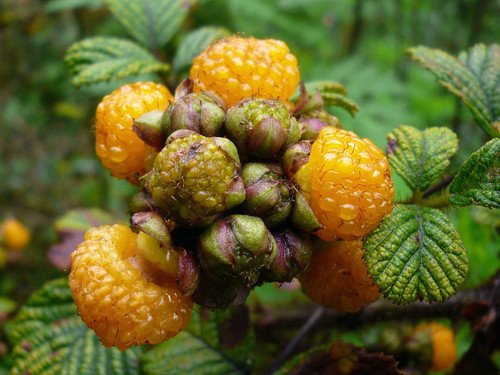The captivating beauty of the Himalayas is indescribable. Snowy peaks, breathtaking valleys and dark forests! The Himalayan mountain range is also home to various plants having medicinal uses. Here are some wild fruits, all found in Uttarakhand, which have been traditionally used for medicinal purpose:

Timla
Botanical name: Ficus auriculata
Medicinal uses: Timla can be used to maintain blood pressure (BP) in people suffering from high blood pressure. It can also be used to treat constipation, as it acts as a laxative and helps to regulate the digestive system. It also has antioxidant and anti-inflammatory properties.
Hisalu
Botanical name: Rubus elliptical sm
These golden-yellow Himalayan raspberries actually belong to the rose family. They are found in the forests of Uttarakhand and Nepal. They are deliciously sour, the way raspberries usually are.
Medicinal uses: Not only does it have a fruity taste, but the berry is also used to treat indigestion. The roots of the Hisalu plant are used to treat abdominal pain and headache.
Kafal
Botanical name: Myrica esculenta
Commonly known as box berry, this fruit is found in the sub-tropical Himalayas. The fruit is sweet, and locals usually eat it whole – seeds and all.
Medicinal uses: Kaphaal is a naturally occurring antioxidant. It is widely used in folk medicine to treat ailments such as cough, chronic bronchitis, ulcers, anemia, fever, diarrhea, and disorders of the ear, nose, and throat.
Plum
Botanical name: Prunus subg. potato
Plums are low-calorie fruits that do not raise your blood sugar. They can be eaten raw, dried or as a jam. The berries of the forests of Uttarakhand are slightly different from the varieties found in metropolitan cities – the fruits are usually bright red and sweet and sour in taste.
Medicinal Uses: Plums are rich in Vitamin C and hence they nourish and purify the skin. They also boost immunity.
Bedu
Botanical name: Ficus palmata
Commonly known as Punjab fig, Bedu is found in the forests of Uttarakhand. The fruit is sweet – as you would expect a fig to be.
Medicinal uses: Bedu helps in relieving inflammation (demulsant) and its juice is used in the treatment of warts. It is also used for the treatment of constipation and diseases of the lungs and bladder. The juice is used by local residents to expel the spines (small needle-like coverings on some fruits and the bark of trees like cacti) deep into the skin.
Ghigaru
Botanical name: Pyracantha cranulata
Ghigaru is also known as Himalayan firethorn and Nepalese firethorn. It tastes a bit like a jamun and makes your mouth a little dry.
Medicinal Uses: The antioxidants present in this fruit help in maintaining blood pressure and lowering cholesterol. It is also rich in beta-carotene (a great source of vitamin A), iron and potassium.
The leaves are used in making herbal teas and sunburn creams. An infusion made by dipping the bark of this shrub is given to girls in case of excessive menstrual bleeding.
Khubani
Botanical name: Prunus armeniaca
Khubani are commonly known as apricot. The yellow-peach-colored fruit is sweet. It belongs to the same family as plum and cherry.
Medicinal Uses: Apricots are great antioxidants. They are highly fibrous and maintain healthy blood sugar and cholesterol levels. They are also rich in vitamin C and potassium.
Mulberry
Botanical name: Morus alba L.
These mulberries are white and can be grown in home gardens as well. They are generally sweeter than red or purple mulberries found in the plains of North India.
Medicinal uses: Mulberry contains bioactive components such as alkaloids and flavonoids that have antioxidant properties. These white mulberries have anti-cholesterol, anti-obesity and hepatoprotective (liver-protecting) effects.
Siriphal
Botanical name: Aegle marmelos (L.)
Siriphal also known as bel, is commonly used for worship or for its medicinal purposes.
Medicinal uses: Clinical studies have shown that algal marmelos has antidiarrheal, antimicrobial, antiviral, radioprotective, antipyretic (fever treatment), ulcer healing, antifertility, and anti-inflammatory properties. These help in the prevention and treatment of many diseases.
Burans
Botanical name: Rhododendron Arborium
Burans is a bright red coloured, bell-shaped flower filled with sweet nectar which is seen in the Himalayan range at an altitude of 1200 m in India, Bhutan and Nepal. While you’ll find bottled barn juice everywhere in stores, the traditional way of consuming the honey-sweetened nectar is straight from the flower.
Medicinal uses: The juice of the bark is used in the treatment of cough, diarrhea and dysentery. Burans have anti-inflammatory, antioxidant and antimicrobial properties. Its juice is said to be beneficial for diabetics.

